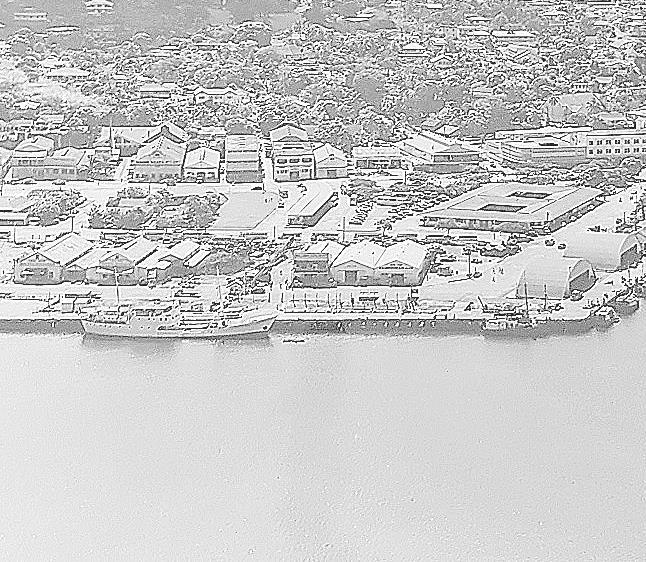“Suva at present consists of three or four houses, a small disused church, a large disused sugar mill, and this disused and deserted hotel.”
This was the one description of the area which had just been chosen to be the colony’s new capital. According to an article published in The Fiji Times on February 6, 1979, in 1880 almost one-eighth of the area in question was represented by “fetid and pestiferous mangrove swamps”.
The town plan, according to the article, resembled “a spider’s web after a strong gale”. Its narrow lanes and alleys by courtesy called streets, “wound tortuously through a ‘rookery’ specially designed to retain the malarious swamp airs”.
Suva’s citizens, the article concluded, were unlikely to escape pestilence or epidemic diseases. The few people who had tried to grow sugarcane in the area had failed. There was too much rain and too little soil over the soapstone.
Brewer and Joske’s mill closed down in 1875, and with it went with the hopes of those planters who had the misfortunate to settle there. The governor’s own niece claimed Suva could be a capital, “perhaps a capital for paupers”.
As for Levuka’s merchants, they just went on with their business, unconcerned the colonial government wanted to shift its offices to a swamp. To them the commercial centre and heart of the colony would always be Levuka.
They were wrong, of course. Levuka was already tickling the sides of the cliffs, hard up against the mountain side with nowhere to go. A capital would needed to be big enough to be the ultimate Fiji city, with a good harbour to it.
Nadi was considered a suitable spot and so was Galoa in Kadavu, which had been a stopover for the San Francisco-Sydney mail steamers even before they ventured into Levuka. Rather than relying on local knowledge, the British did their usual thing and sent over an expert to pick the spot.
That was when Colonel Smythe picked Suva. He described its beautiful harbour and surrounding hillsides as a perfect location and one of the prettiest localities in all Fiji. Somehow, the good colonel only managed to visit the site on a sunny day.
But the real clincher came when two very smart Melbourne merchants made a little gift to government. They owned a large tract of Suva land which was, after the collapse of both the Polynesian Company and sugar efforts, next to worthless.
They offered half of it to government free – every second lot – plus a site for government offices, providing that Suva became the capital. Samuel Renwick and William Thomson knew that if their offer was accepted the remaining half of their land would skyrocket in value.
The offer was accepted and by 1877 the Home Office and the Queen had given approval for the move. The swamp was to be transformed, and Colonel Pratt of the Royal Engineers was given the primary responsible for it.
The colonel allowed his artistry run away with him. Streets which looked fine on paper didn’t seem to follow the natural formations of the land and this resulted in his plan being termed a disaster.
Slowly but surely, Victoria Pde and Thomson St egan to take shape along the wharf. Indian labourer’s who had arrived a few months earlier in the Leonidas and numbers of New Hebridean and Solomon Island indentured labourers were used to clear the land.
In October, 1880, a small crowd gathered under an ivi tree in what was to eventually be the centre of the town to witness the first public sale of Suva land. This also didn’t go very well. Only six or seven lots were sold and this left Levuka seeming to be a better investment. Victoria Pde was still described as having “barely room for handcart, a danger to life and limb”, and pedestrians still
“wandered through the mud, unable to tell whether they were on the street or off”. Right when things seemed to be falling apart, it was made known that the government would be travelling from Levuka to the mainland to ensure developments were being made.
Just before midnight on August 30, 1882, the governor and numerous other department heads boarded the Ice Queen in Levuka for the trip to their new capital. The paper termed it a “heartless desertion”, saying “such a serious defection in the manner of dignity and social consequences may probably have the effect of making Levuka rather dull for some time to come”.
The famous pigeon post was in operation for years between Suva and Levuka, keeping both centers informed of significant events, including shipping and race results. One example of the message carried in a note clipped to the bird’s leg was “no appearance of either Melbourne or Sydney steamers.
Lord of the Isles arrived on Sunday. In the Sheffield Maid Handicap, Turner was first…” Remarkably enough, the birds usually got it through.
There was only one reported incident where a misguide pigeon landed aboard a ship near Kadavu, but was dispatched again after rest, and it reached Levuka with its message intact, along with one from the ship’s captain.
By the turn of the century, Suva had a weekly overlaid mail service to the new sugar area – Lautoka. Fijian runners were hired to carry up to 30lbs mail in a leather bag to sprint to a specific point where another runner waiting to receive it.
Runners ran day and night before finally reaching Suva. Suva’s principal recreation was the meeting hall.



